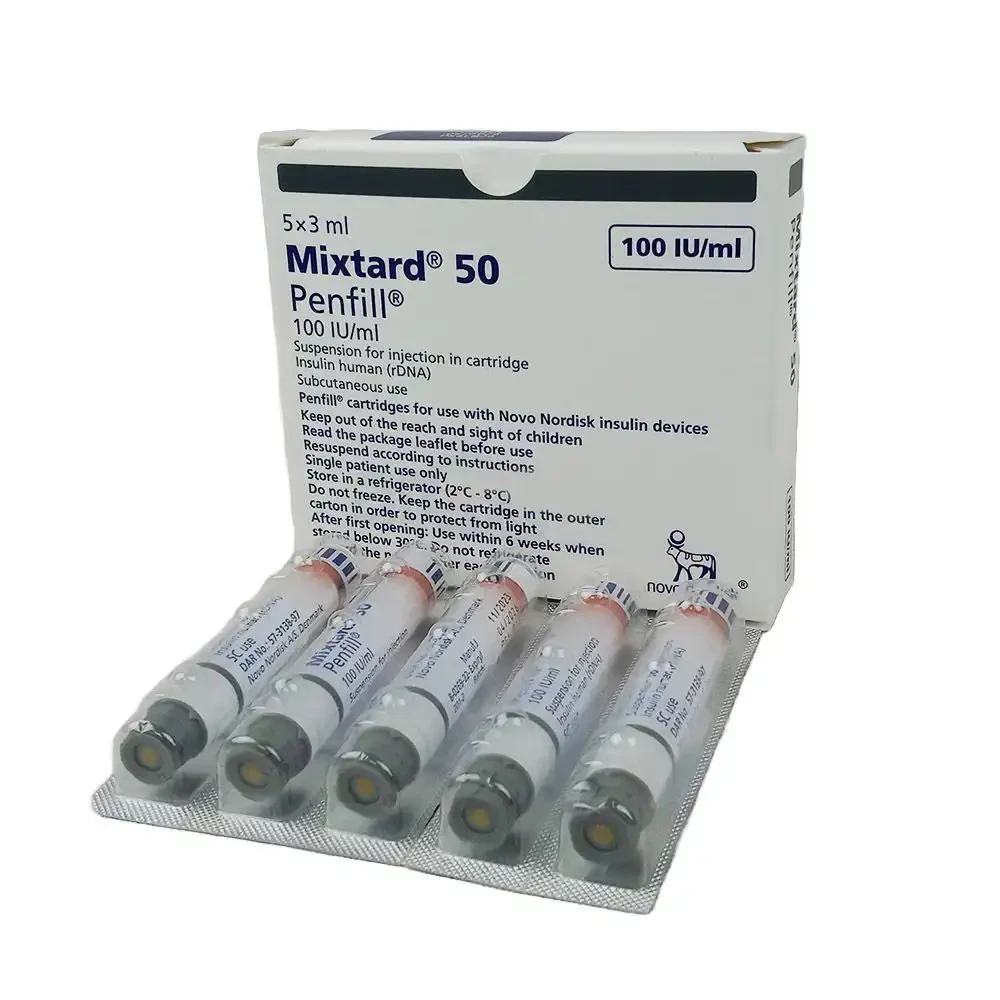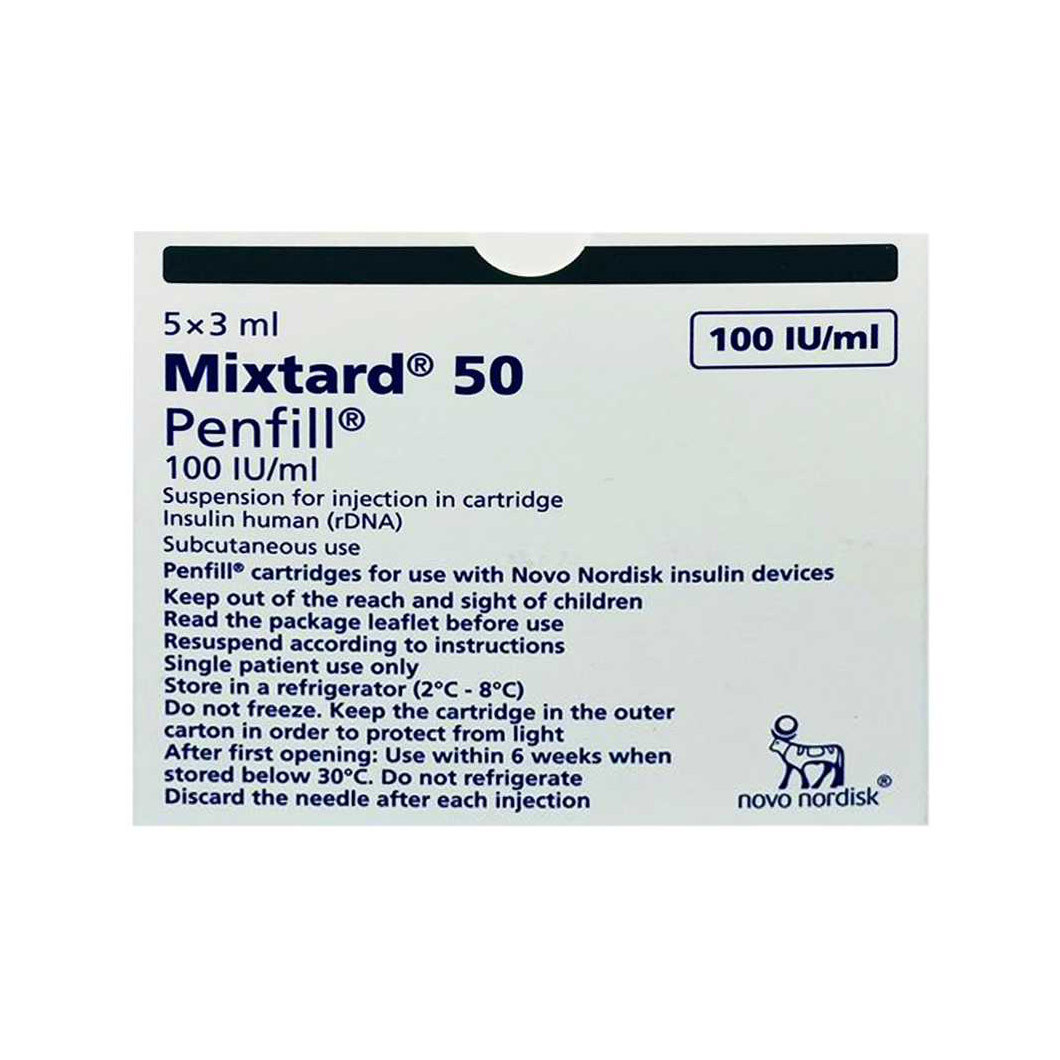Mixtard 50 SC Injection
Pack Images
50%+50% in 100 IU/ml
3 ml penfill:
৳ 460.00
(5's pack: ৳ 2,300.00)
Also available as:
Indications
Mixtard 50 injection is indicated for-
- Treatment of all patients with type 1 diabetes
- Treatment of patients with type 2 diabetes who are not adequately controlled by diet and/ or oral hypoglycemic agents
- For the initial stabilization of diabetes in patients with diabetic ketoacidosis, hyperosmolar non-ketotic syndrome and during periods of stress such as severe infections and major surgery in diabetic patients
- Treatment of gestational diabetes
Composition
30/70: Each ml suspension contains Insulin Human (rDNA) USP 100 IU (equivalent to 3.47 mg) as 30% Regular Insulin Human and 70% Isophane Insulin Human.
50/50: Each ml suspension contains Insulin Human (rDNA) USP 100 IU (equivalent to 3.47 mg) as 50% Regular Insulin Human and 50% Isophane Insulin Human.
50/50: Each ml suspension contains Insulin Human (rDNA) USP 100 IU (equivalent to 3.47 mg) as 50% Regular Insulin Human and 50% Isophane Insulin Human.
Pharmacology
The blood glucose lowering effect of insulin is due to the facilitated uptake of glucose following binding of insulin to receptors on muscle and fat cells and to the simultaneous inhibition of glucose output from the liver. Insulin has a half-life of a few minutes in the blood stream. No profound binding to plasma proteins.
An average action profile after subcutaneous injection indicates:
An average action profile after subcutaneous injection indicates:
- Onset of action- within 30 minutes
- Peak plasma levels attained between 1-3 hours
- Duration of action- approximately 18-24 hours
Dosage
Dosage is individual and determined by the physician in accordance with the needs of the patient.
The average range of total daily insulin requirement for maintenance therapy in type 1 diabetic patients lies between 0.5 and 1.0 IU/Kg. In pre-pubertal children it usually varies from 0.7 to 1.0 IU/ Kg.
The daily insulin requirement may be higher in patients with insulin resistance (e.g. during puberty in the young or due to obesity) and lower in patients with endogenous insulin production or during the period of partial remission.
Initial dosage for type 2 diabetic patients are often lower, e.g. 0.3 to 0.6 IU/ Kg/ Day.
An injection should be followed within 30 minutes by a meal or snack containing carbohydrates.
The average range of total daily insulin requirement for maintenance therapy in type 1 diabetic patients lies between 0.5 and 1.0 IU/Kg. In pre-pubertal children it usually varies from 0.7 to 1.0 IU/ Kg.
The daily insulin requirement may be higher in patients with insulin resistance (e.g. during puberty in the young or due to obesity) and lower in patients with endogenous insulin production or during the period of partial remission.
Initial dosage for type 2 diabetic patients are often lower, e.g. 0.3 to 0.6 IU/ Kg/ Day.
An injection should be followed within 30 minutes by a meal or snack containing carbohydrates.
Administration
Administration
- It is usually administered subcutaneously in the abdominal wall. The thigh, the gluteal region or the deltoid region may also be used.
- Subcutaneous injection into the abdominal wall ensures a faster absorption than from other injection sites.
- In order to avoid lipodystrophy, injection sites for a given insulin preparation should be rotated within an anatomic region.
- Concomitant illness, especially infections and feverish conditions, usually increases the patient's insulin requirement.
- Renal or hepatic impairment may reduce insulin requirement.
- Adjustment of the dosage may also be necessary if patients change physical activity or their usual diet.
- Dosage adjustment may be necessary when transferring patients from one insulin preparation to another.
- Make sure it is the right type of insulin
- Always check the cartridge including the rubber plunger (stopper)
- Disinfect the rubber membrane with surgical spirit
- If cartridge or the device containing cartridge is dropped or crushed, there is a risk of damage and leakage of insulin
- If it has not been stored correctly or been frozen
- If it is not uniformly white and cloudy when it is mixed
- Before putting the cartridge into the insulin delivery system, move it slowly up and down between positions A and B and back (see the picture) so that the glass ball moves from one end of the cartridge to the other. Repeat this movement before first use at least 20 times and for every injection at least 10 times. The movement should always be repeated until the liquid appears uniformly white and cloudy. Complete the other stages of injection without delay.
- If the cartridge is already inside the insulin delivery system, move the delivery system slowly up and down between A and B and back with the cartridge inside at least 10 times. Do this again before every injection.
- Inject the insulin under the skin. Use the injection technique described in the delivery system manual
- Keep the needle under the skin for at least 6 seconds to make sure that the full dose has been delivered
- After each injection be sure to remove the needle. Otherwise the liquid may leak out when the temperature changes and the strength of the insulin may change.
Interaction
Concomitant use of other drugs may influence insulin requirements.
The following substances may reduce the insulin requirements: Oral hypoglycemic agents (OHA), monoamine oxidase inhibitors (MAOI), non-selective beta-blocking agents, angiotensin converting enzyme (ACE) inhibitors, Salicylates and Alcohol.
The following substances may increase the insulin requirements: Thiazides, glucocorticoids, thyroid hormones and beta-sympathomimetics, growth hormone and Danazol.
Beta-blockers may mask the symptoms of hypoglycemia and delay recovery from hypoglycemia. Octreotide/ Lanreotide may both increase and decrease insulin requirement. Alcohol may intensify and prolong the hypoglycemic effect of insulin.
The following substances may reduce the insulin requirements: Oral hypoglycemic agents (OHA), monoamine oxidase inhibitors (MAOI), non-selective beta-blocking agents, angiotensin converting enzyme (ACE) inhibitors, Salicylates and Alcohol.
The following substances may increase the insulin requirements: Thiazides, glucocorticoids, thyroid hormones and beta-sympathomimetics, growth hormone and Danazol.
Beta-blockers may mask the symptoms of hypoglycemia and delay recovery from hypoglycemia. Octreotide/ Lanreotide may both increase and decrease insulin requirement. Alcohol may intensify and prolong the hypoglycemic effect of insulin.
Contraindications
This should never be given to patients with hypoglycemia & hypersensitivity to human insulin or any of the excipients.
Side Effects
Adverse drug reactions observed in patients using human insulin are mainly dose-dependent and due to the pharmacologic effect of insulin. As for other insulin products, hypoglycemia, in general is the most frequently undesirable effect. It may occur if the insulin dose is too high in relation to the insulin requirement. Lipodystrophy may occur at the injection site as a consequence of failure to rotate injection sites within an area. Symptoms of generalized hypersensitivity may include generalized skin rash, itching, sweating, gastrointestinal upset and angioneurotic oedema, difficulties in breathing, palpitation and reduction in blood pressure. Generalised hypersensitivity reactions are potentially life threatening. Edema may occur upon initiation of insulin therapy. These symptoms are usually of transitory nature.
Pregnancy & Lactation
There are no restrictions on the treatment of diabetes with insulin during pregnancy as insulin does not pass the placental barrier. Both hypoglycemia and hyperglycemia, which can occur in inadequately controlled diabetes therapy, increase the risk of malformations and death in utero. Insulin requirements usually fall in the first trimester and increase subsequently during the second and third trimesters. After delivery, insulin requirements return rapidly to pre-pregnancy values. Insulin treatment of the nursing mother involves no risk to the baby. However, the insulin dosage, diet or both may need to be adjusted.
Precautions & Warnings
Inadequate dosing or discontinuation of treatment, especially in type 1 diabetes, may lead to hyperglycemia. In type 1 diabetes, untreated hyperglycemic events eventually leads to diabetic ketoacidosis which is potentially lethal.
Hypoglycemia may occur if the insulin dose is too high in relation to the insulin requirement.
Transferring a patient to another type or brand of insulin should be done under strict medical supervision.
Changes in strength, brand (manufacturer), type (rapid acting insulin, dual acting insulin, intermediate and long acting insulin etc.), species (animal, human insulin analogue) and/or method of manufacture (recombinant DNA versus animal source insulin) may result in the need for a change in dosage.
Before traveling between different time zones, the patients should be advised to consult the doctor, since this may mean that the patients has to take insulin and meals at different time.
It should not be used if there are clumps in the insulin after mixing and should not be used if solid white particles stick to the bottom or wall of the bottle, giving it a frosted appearance.
Hypoglycemia may occur if the insulin dose is too high in relation to the insulin requirement.
Transferring a patient to another type or brand of insulin should be done under strict medical supervision.
Changes in strength, brand (manufacturer), type (rapid acting insulin, dual acting insulin, intermediate and long acting insulin etc.), species (animal, human insulin analogue) and/or method of manufacture (recombinant DNA versus animal source insulin) may result in the need for a change in dosage.
Before traveling between different time zones, the patients should be advised to consult the doctor, since this may mean that the patients has to take insulin and meals at different time.
It should not be used if there are clumps in the insulin after mixing and should not be used if solid white particles stick to the bottom or wall of the bottle, giving it a frosted appearance.
Overdose Effects
Insulins have no specific overdose definitions. However, hypoglycemia may develop over sequential stages:
Mild hypoglycemic episodes can be treated by oral administration of glucose or sugery products.
Severe hypoglycemic episodes, where the patient has become unconscious, can be treated by Glucagon (0.5 to 1 mg) given intramuscularly or subcutaneously by a trained person or glucose given intravenously by a medical professional. Glucose must also be given intravenously, if the patient does not respond to Glucagon within 10 to 15 minutes.
Upon regaining consciousness administration of oral carbohydrate is recommended for the patient in order to prevent relapse.
Mild hypoglycemic episodes can be treated by oral administration of glucose or sugery products.
Severe hypoglycemic episodes, where the patient has become unconscious, can be treated by Glucagon (0.5 to 1 mg) given intramuscularly or subcutaneously by a trained person or glucose given intravenously by a medical professional. Glucose must also be given intravenously, if the patient does not respond to Glucagon within 10 to 15 minutes.
Upon regaining consciousness administration of oral carbohydrate is recommended for the patient in order to prevent relapse.
Storage Conditions
Insulin preparations should be stored between 2°C and 8°C (in a refrigerator). Insulin preparations which have been frozen must not be used. Insulin preparation should be kept in the outer carton in order to protect from light. Insulin preparations should be protected from excessive heat or sunlight. When in use the cartridge should not be refrigerated. Once in use the cartridge may be used for up to 6 weeks when stored below 25 o C or 4 weeks when stored below 30°C. Preparation should be mixed thoroughly before use, preferably by rolling the cartridges slowly between the hands.
Pack Images: Mixtard 50 50% 50% Injection



